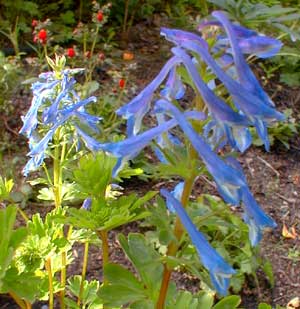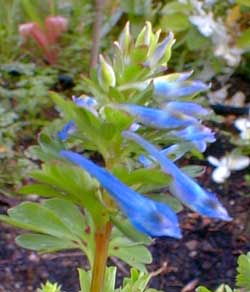
Blue Corydalis; aka,
Blue False Bleeding Heart
Corydalis elata is often compared to C. flexuosa, the unusual bloom being identically guppy-shaped of a brilliantly transluscent blue. But its habits are quite distinct. C. flexuosa blooms early spring, dies back late in the summer, returns occasionally to rebloom in autumn, then vanishes in winter; it's a wonderful plant but very scruffy & miserable-looking during its summer dormancy.
C. elata by contrast is at its floweriest in late spring & summer (May until the start of July), & the foliage persists most of the year, being semi-evergreen. The ferny leaves are a bit larger & more upright than C. flexuosa, & on close examination have a tiny red dot on each leaf.
 Because C. elata has features that exceed the undeniable charms of C. flexuosa plus is simply hardier in the garden, there are some who believe the popularity of C. flexuosa cultivars may decline in favor of this sturdier corydalis.
Because C. elata has features that exceed the undeniable charms of C. flexuosa plus is simply hardier in the garden, there are some who believe the popularity of C. flexuosa cultivars may decline in favor of this sturdier corydalis.But I feel the early flowering & late reflowering of C. flexuosa insures it a lasting place in gardening preferences, in the Puget Sound region at least, where conditions suit it ideally. In slightly warmer zones where it has always been a frustrating or shortlived perennial, then certainly C. elata will be the primary choice.
The clump grows upright to a foot or sixteen inches, with heavy sprays of blue flowers reaching to nearly two feet. It will slowly spread to two feet wide or wider.
The flowers can be cut for bouquets, & on warm days have the redolence of gardenia mixed with coconut.
It is perfect for a woodland garden. It wants dappled sunlight or partial shade, persistently moist but well-draining humusy soil. It is especially important the soil never entirely dries out in summer, so that it keeps its good looks, though an established clump won't actually be killed by momentary droughtiness. It is very apt to self-seed, & young plants that pop up anywhere they're not wanted can be transferred to pots to become very welcome gifts to fellow gardeners.
Originating in southwest Sichuan Province of China, the first C. elata to reach European & American gardeners were from plants collected on Mount Omei, & propogated by Elizabeth Strangman of Washfield Nursery in Kent, England. The normal original species took some while to make it into widespread production, & in the meantime several cultivated forms & a couple of hybrids arose among the more specialized growers. Oh, & we have at least one other of Ms. Strangman's discoveries in our gardens, Geranium phaeum 'Samobor.'